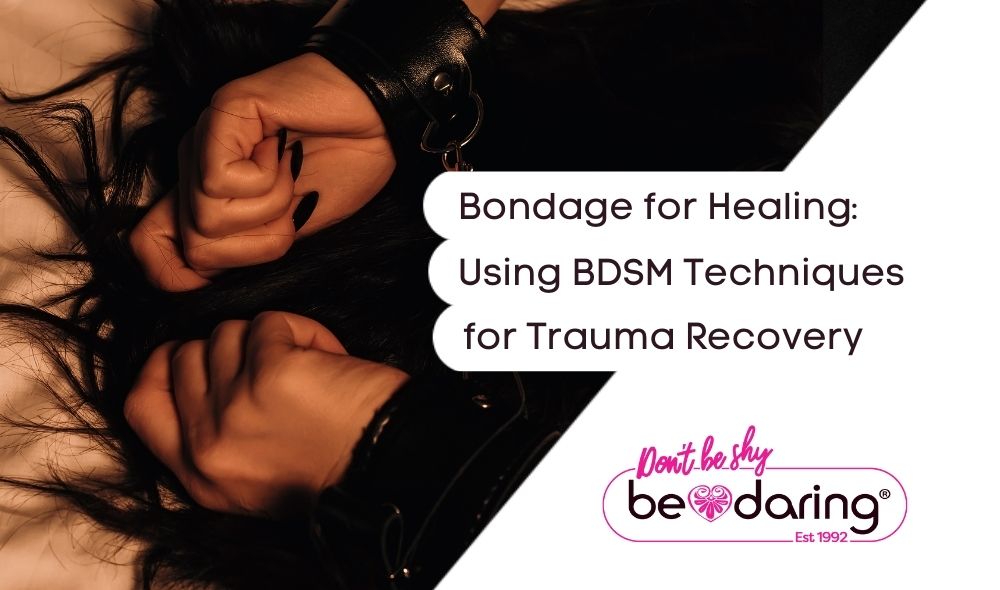Bondage for Healing: Using BDSM Techniques for Trauma Recovery
Categories
Topics
- Sexual Health
- Women's Masturbation
- Women's Self Pleasure
- Anal Sex
- Gay Sex
- Butt play
- Ass Play
- Ass Sex
- Adult retail
- Buying sex toys
- Sex & Relationships
- Sexy Events
- Sexual Wellness
- LGBTQIA+
- Dry Herb Vaporizers
- Adult Lifestyle
- Buying Sex Toys
- Sexual Relationships
- How To Build a Sex Room
- Bondage
- BDSM
- Bad Dragon Dildos
- Lingerie
- Cleaning sex toys
- Sex dolls
- Wax Play
- Women's Wellness
- Sex Machines
- Sex Education
Tags

Somatic techniques can support our nervous systems as an alternative healing modality. Kink can be described as a sensual, intimate, and strong somatic practice that many people find therapeutic. There is strength in reclaiming areas of your sexuality that have been buried or are motivated by shame as a result of past trauma. Kink is interdisciplinary, thus the actual practice differs depending on who participates. This is because kinks can take numerous forms, including suspension play, role play, physical constraint, power exchange, pain administration, impact, and age play, to name a few. In other words, there is no one way to be kinky, and discovering your own route is essential.
Though kinky behaviour has traditionally been classified as "Sexual Sadism and Sexual Masochism Disorders," research indicates that people who practise BDSM are less neurotic, more extroverted, more open to new experiences, more conscientious, less rejection sensitive, and have higher subjective well-being than non-kinky people.
Kink is really about the ability to go into the depths of your wants while also connecting with the raw humanity of others. It can be viewed as "shadow work": gaining strength in submitting and embodying power. This type of connection requires vulnerability, trust, and intentional communication.
Negotiation predictability
Survivors of sexual assault can find deep reclamation via scene negotiation, execution, and aftercare. Correlations have been found between the stages of trauma healing therapies and the three phases of a kink scene. The first phase of trauma work with a mental health provider focuses on developing skills. You concentrate on developing reliable coping mechanisms and self-imposed boundaries in response to stressors. This refers to the initial step in a kink scene: bargaining. You determine with your partner(s) what everyone's boundaries are, what type of play you want to engage in, and what your safe words or acts are. Planning a scene gives survivors a sense of certainty about what will happen, whereas a traumatic incident is entirely random.
Rewiring trauma
Working with trauma in therapy is a safe and contained method to find recovery. BDSM play, like kink scene play, allows you to experience pain, fear, excitement, desire, and adrenaline consensually. You get to choose the type of scene you want to do, whether it's suspension, needle play, or age play; kink creates a space where people can choose to be powerful, experience pain, and then be cared for. This consenting feature of play enables our bodies to reprogram our brain and nervous system reactions. Creating new positive and consensual experiences can help to recover and "overwrite" previous traumatic ones.
Aftercare and repairs
The most critical stage of trauma therapy is integration, which is analogous to aftercare in a kink environment. Using the skills acquired in previous levels, survivors have a safety plan and a better understanding of their trauma. During aftercare, you check in with one another to see how the scene went, what worked and what didn't, what you want to try again with more intensity the next time, and offer care through snuggles, soft touches, or affirmations. Kink completes the stress response cycle for those who are stuck in an activated state of fight or flight, allowing the body to deactivate and restore itself. The strong bond of trust and communication between spouses enables for the dismantling of trauma-related barriers. While trauma results in a rupture that cannot be repaired, aftercare in a kink scene allows for rehabilitation after experiencing consensual pain, submission, or intensity.
Pleasurable play
Research on sexual assault survivors who experience pleasure, intimacy, and connection after trauma is scant or nonexistent. Many trauma survivors talk of feeling disoriented when attempting to re-navigate their sexuality following the event. Everyone's approach to rewiring a connection to pleasure will be different; kink and BDSM inclusion is just one option. Playfulness is not something that many adults get to experience because it's something we're supposed to grow out of. Playful pleasure, however, provides a healing place. Kink is essentially a sort of play, including age play, fetish play, fantasy, role play, power play, and so on. Not only do we heal in the present moment, but portals are opened to heal our former selves and restore areas where traumatic energy may be lodged in the body. When you understand where traumatic energy is housed in your body, you can direct your kinky efforts there. For example, if you struggle to communicate boundaries due to past trauma, having a dominant explore breathe play with you could be a point of concentration, or releasing a scream during a hard impact play scene could release trauma by completing the stress response cycle. This type of kinky play involves inventiveness.
















